这几天在学CSS,看了W3school对position的解释,不是很明白,所以今天决定网上搜索重学position,以此记录一下
position有个四个属性:
- relative
- absolute
- fixed
- static
初始时的div
<div class="sub1">
sub1
</div>
<div class="sub2">
sub2
</div>
CSS如下:
.sub1{
background-color: green;
font-size: 24px;
/* position: relative; */
top:100px;
}
.sub2{
background-color: black;
font-size: 24px;
color: white;
}
显示效果:

relative
relative,相对位置,设置了relative属性,sub1会根据其正常的位置相对的移动,移动的距离依据所设置的 top,bottom,right,left所决定,一句话就是sub1如果不设置relative时它应该在哪里,一旦设置后就按照它理应在的位置进行偏移。sub2因为没有设置relative属性所以,他的位置不动,他不受sub1的影响。relative的偏移是基于对象的margin的左上侧的。
<div class="sub1">
sub1
</div>
<div class="sub2">
sub2
</div>
CSS如下:
.sub1{
background-color: green;
font-size: 24px;
position: relative;//设置relative属性
top:10px;//top移动10像素
left: 15px;//left移动15像素
}
.sub2{
background-color: black;
font-size: 24px;
color: white;
}

可以看到sub1依据top和left的值进行了相对的移动,而sub2没有受影响
absolute
absolute绝对定位,当sub1设置为absolute时其位置分为两种情况,1)sub1有父标签且父标签的position设置为relative或者absolute,sub1的位置就根据这个父标签的位置来定位。2)sub1没有父标签或者父标签没有设置position,sub1的位置根据 body来定位。特别要注意的是,absolute定位使元素的位置与文档流无关,因此不占据空间。absolute定位的元素和其他元素重叠。
<div class="sub">
<div class="sub1">
sub1
</div>
<div class="sub2">
sub2
</div>
</div>
.sub{
width: 200px;
background-color: red;
/* position: relative;
top: 50px;
left: 60px; */
/* margin: 50px; */
}
.sub1{
width: 100px;
background-color: green;
font-size: 24px;
/* position: absolute;
top:10px;
left: 30px; */
}
.sub2{
background-color: black;
font-size: 24px;
color: white;
width: 100px;
}
最初始的效果:
.sub{
width: 200px;
background-color: red;
/* position: relative;
top: 50px;
left: 60px; */
/* margin: 50px; */
}
.sub1{
width: 100px;
background-color: green;
font-size: 24px;
position: absolute;
top:10px;
left: 30px;
}
sub1加上了absolute属性,而父标签没有设置position,所以sub1的位置依据body来定位,absolute定位使元素的位置与文档流无关,因此不占据空间,所以sub2的位置变成了原来sub1的位置

为了能跟直观的感觉sub1的位置依据body来定位,我们给sub加上margin,但没有加position
.sub{
width: 200px;
background-color: red;
这一段是注释掉了的,上面的也是,要仔细看
/* position: relative;
top: 50px;
left: 60px; */
margin: 50px;
}
.sub1{
width: 100px;
background-color: green;
font-size: 24px;
position: absolute;
top:10px;
left: 30px;
}
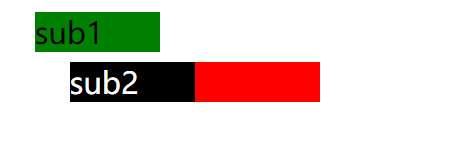
可以看到sub1没有受sub影响
当sub设置了position后,我们再来看看sub1的位置是如何定位的
.sub{
width: 200px;
background-color: red;
position: relative;
top: 50px;
left: 60px;
/* margin: 50px; */
}
.sub1{
width: 100px;
background-color: green;
font-size: 24px;
position: absolute;
top:10px;
left: 30px;
}
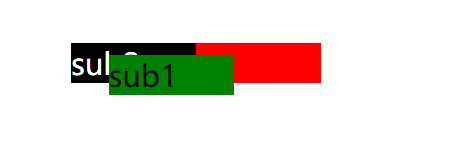
可以看到sub1的位置是跟sub来定位了。再就是absolute定位使元素的位置与文档流无关,因此不占据空间,所以sub2的位置变成了原来sub1的位置
fixed
fixed是特殊的absolute,它总是根据body定位,不管有没有父标签即使是父标签设置了position
初始CSS
<div class="sub">
<div class="sub1">
sub1
</div>
<div class="sub2">
sub2
</div>
<div class="sub3">
sub3
</div>
</div>
.sub{
width: 200px;
background-color: red;
/* position: relative;
top: 50px;
left: 60px; */
margin: 50px;
}
.sub1{
width: 100px;
background-color: green;
font-size: 24px;
/* position: absolute;
top:10px;
left: 30px; */
}
.sub2{
background-color: black;
font-size: 24px;
color: white;
width: 100px;
}
.sub3{
background-color: blue;
font-size: 24px;
color: deeppink;
width: 100px;
/* position: fixed; */
top:10px;
left: 30px;
}
初始效果:
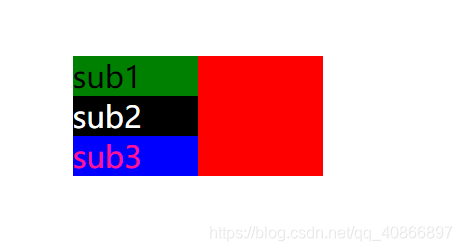
接着给sub的position设置为relative,sub3的position设置为fixed,可以看到即使sub的position设置为relative,sub3还是依据body定位
.sub{
width: 200px;
background-color: red;
position: relative;
top: 50px;
left: 60px;
/* margin: 50px; */
}
.sub1{
width: 100px;
background-color: green;
font-size: 24px;
/* position: absolute;
top:10px;
left: 30px; */
}
.sub2{
background-color: black;
font-size: 24px;
color: white;
width: 100px;
}
.sub3{
background-color: blue;
font-size: 24px;
color: deeppink;
width: 100px;
position: fixed;
top:10px;
left: 30px;
}
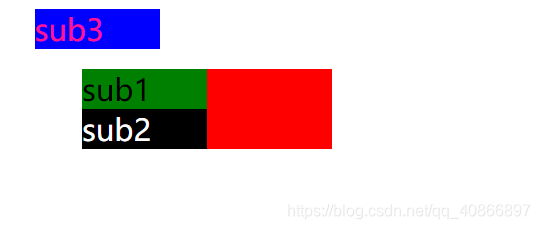
因为fixed是特殊的absolute,所以fixed定位使元素的位置也与文档流无关,因此不占据空间,所以sub3的位置变成了原来sub2的位置
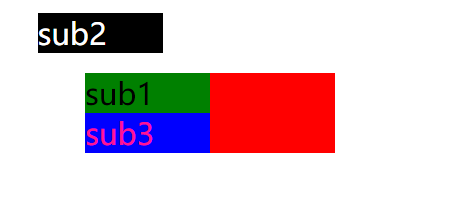
static
HTML元素的默认值,即没有定位,元素出现在正常的流中。静态定位的元素不会受到top, bottom, left, right影响。
这次就介绍到这里,以后学的更深了会继续更新,因为是刚学,如果有说错的地方,欢迎指出一起学习。




 本文深入解析CSS中的position属性,包括relative、absolute、fixed和static四种定位方式。通过实例演示每种定位方式的效果,帮助读者理解元素如何在页面中定位。
本文深入解析CSS中的position属性,包括relative、absolute、fixed和static四种定位方式。通过实例演示每种定位方式的效果,帮助读者理解元素如何在页面中定位。

















 2148
2148

 被折叠的 条评论
为什么被折叠?
被折叠的 条评论
为什么被折叠?










